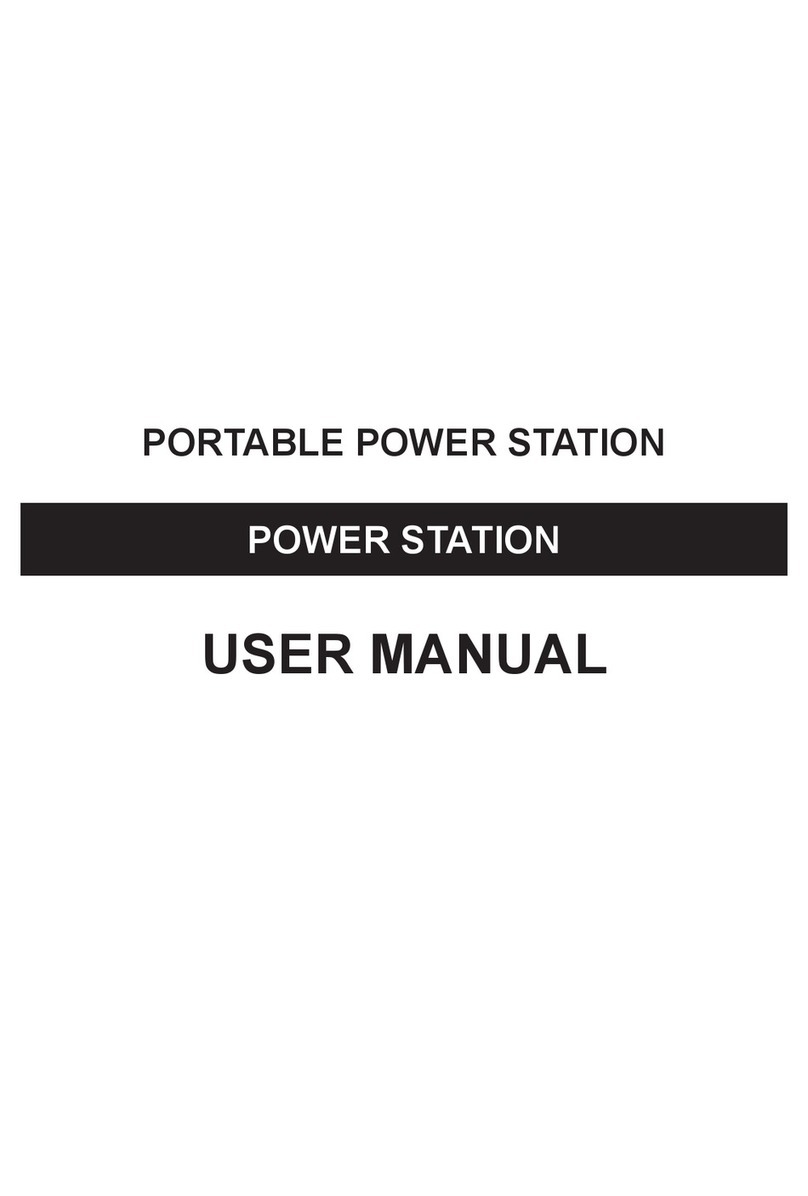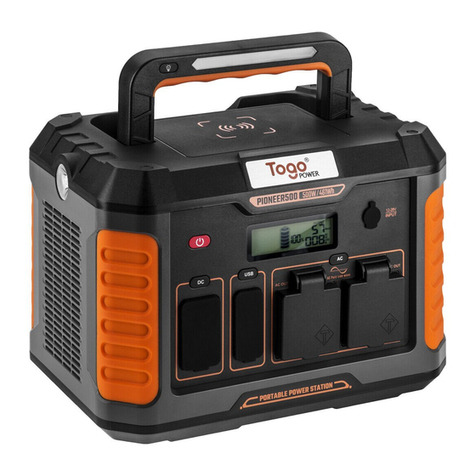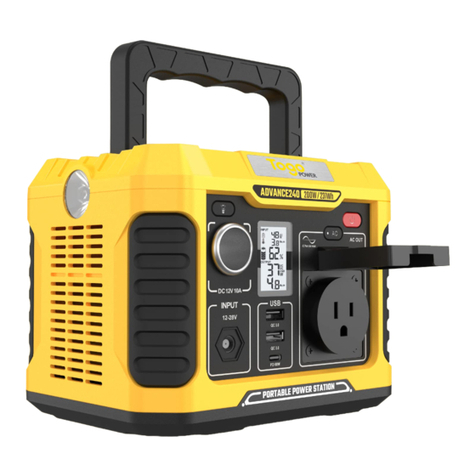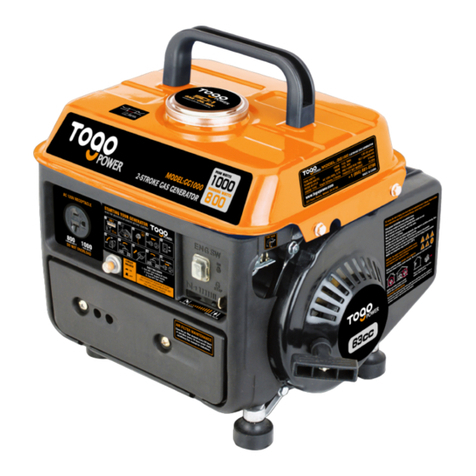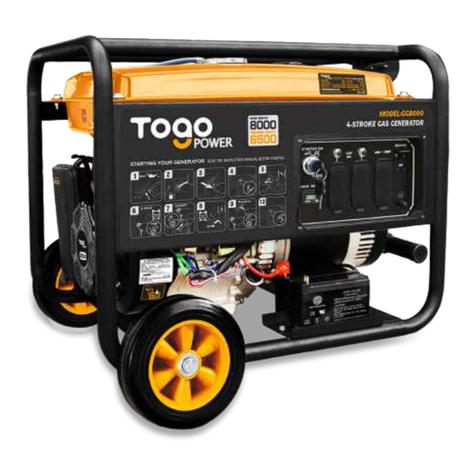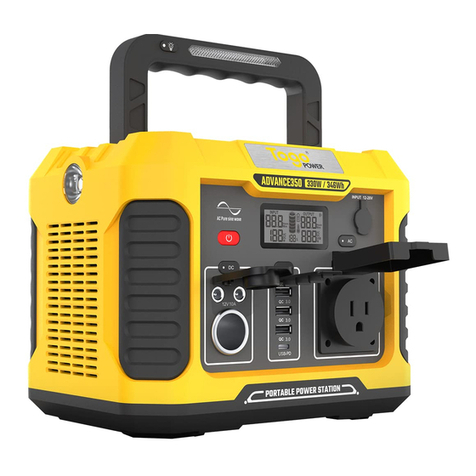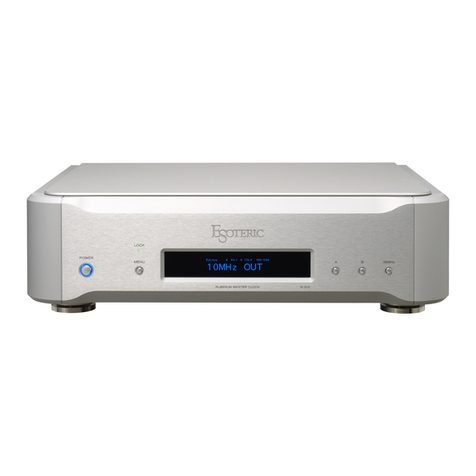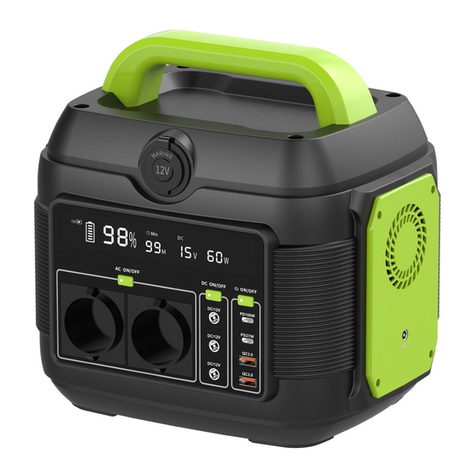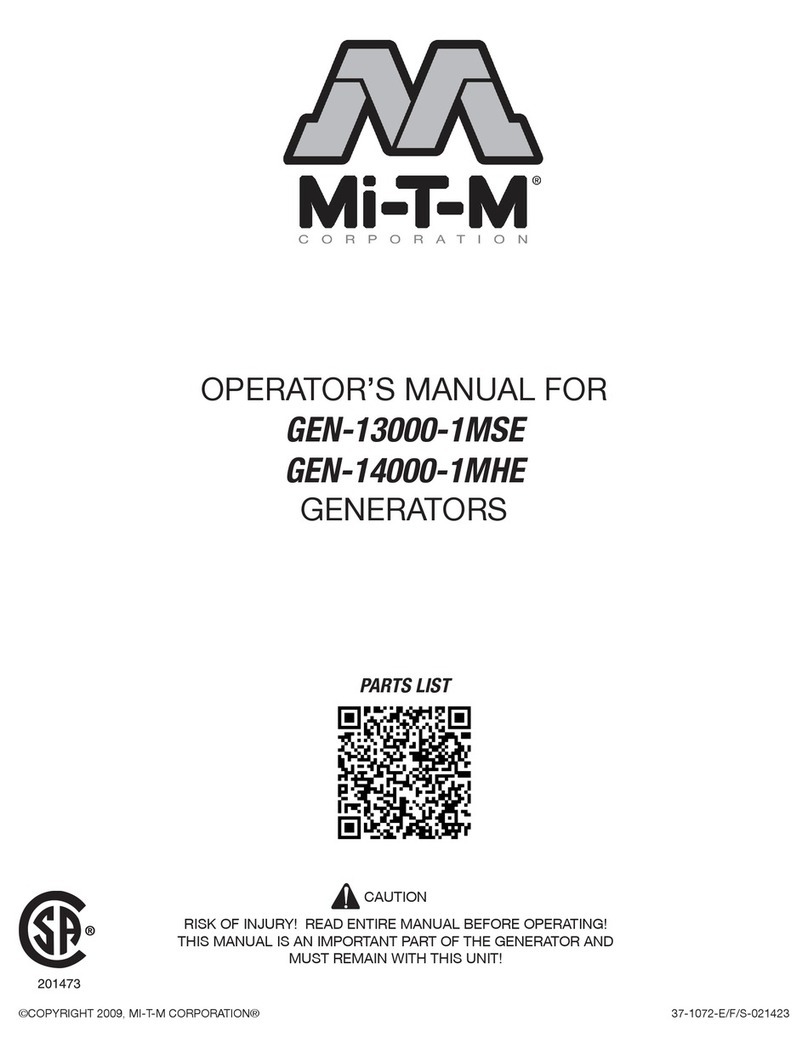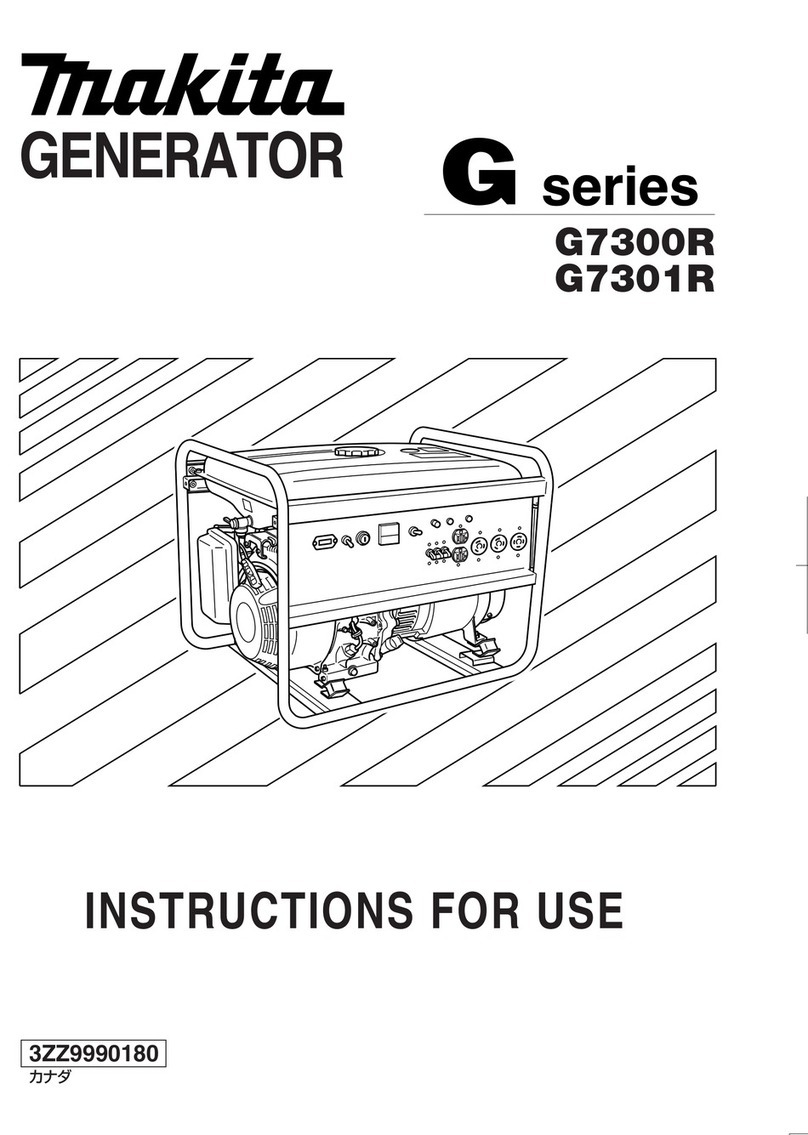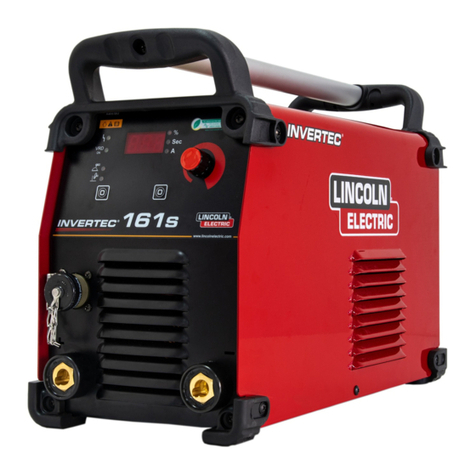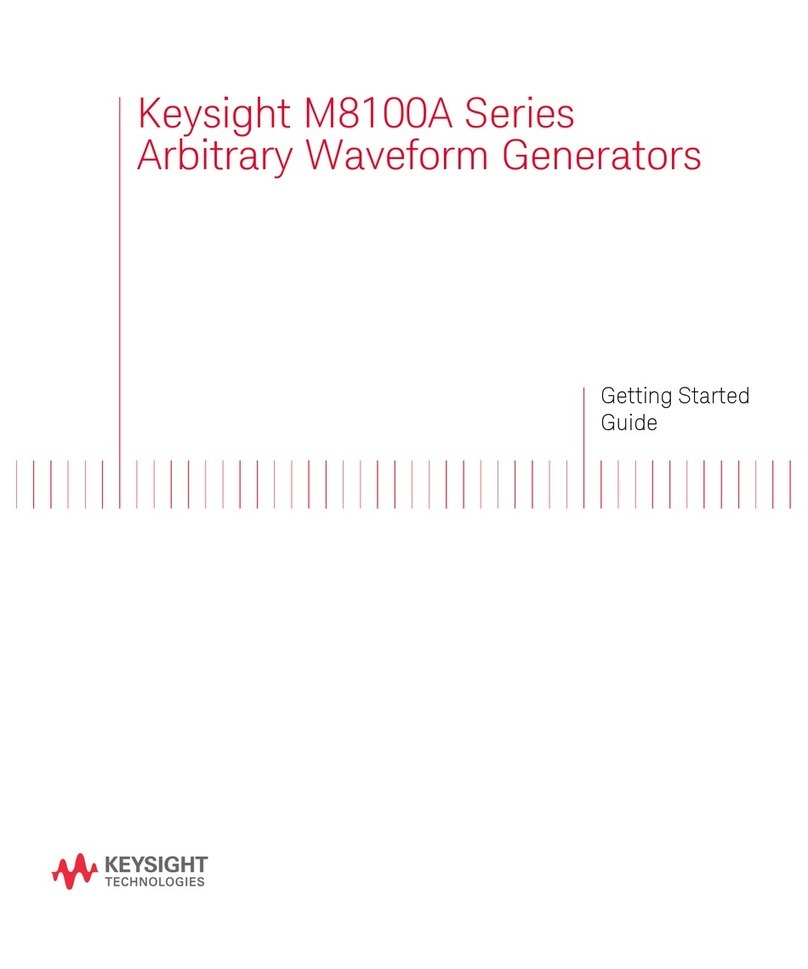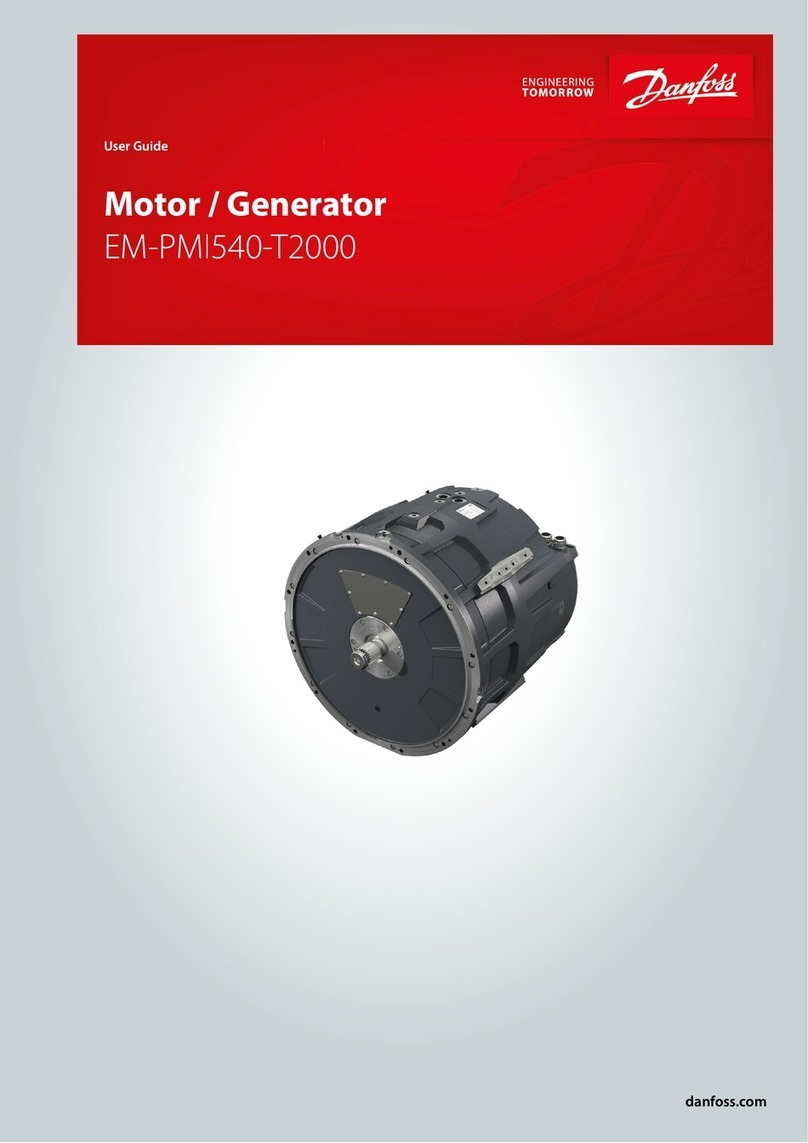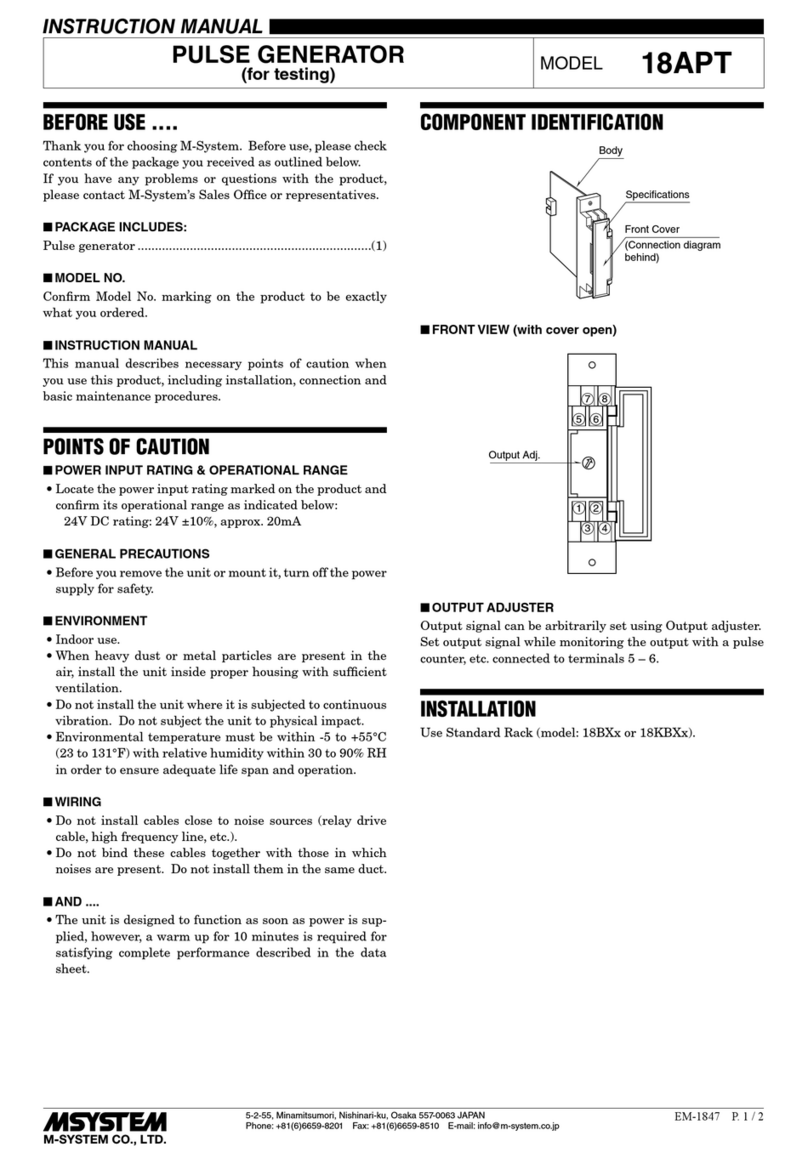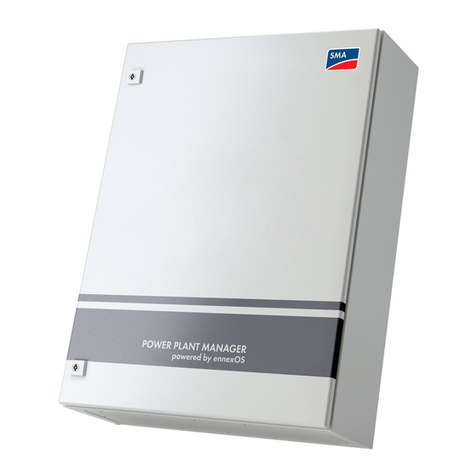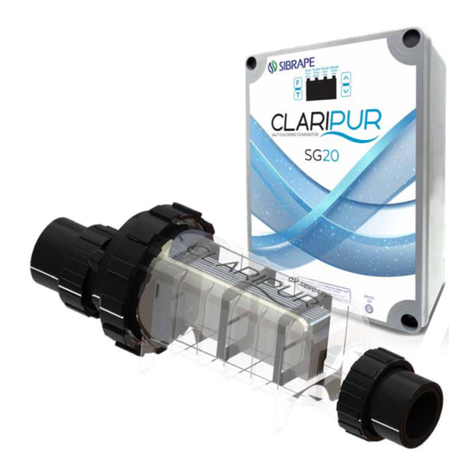Togo POWER GG3600 User manual


Table of Contents
Section 1 Introduction and Safety.................................................................... 1
Section 2 General Information and Setup........................................................ 4
Section 3 Operation ........................................................................................ 9
Section 4 Maintenance and Troubleshooting .................................................. 12
Introduction
Safety Rules
Safety Symbols and Meanings
Exhaust and Location Hazards
Electrical Hazards
Fire Hazards
Replacement Hazard Labels
1
1
1
2
2
3
3
Generator Components
Know Your Generator
Emissions
Product Specifications
Hour Meter
Connection Plugs
Remove Contents from Carton
Accessories
Assembly
Add Engine Oil
Fuel
4
4
5
5
6
6
6
7
7
8
8
Operation and Use Questions
Before Starting Engine
Prepare Generator for Use
Grounding the Generator When Used as a Portable
Know Generator Limits
Wattage Reference Guide
Transporting/Tipping of the Unit
Starting Pull Start Engines
Low Oil Level Shutdown System
9
9
9
9
9
10
10
10
11
Maintenance
Maintenance Schedule
Preventive Maintenance
Engine Maintenance
Inspect Muffler and Spark Arrestor
Valve Clearance
Storage
Troubleshooting
12
12
12
12
14
14
15
16
......................................................................................................
......................................................................................................
.......................................................................................................
................................................................................................
.........................................................................................
...........................................................................................
.................................................................................................
...............................................................................
.......................................................................................................
...........................................................................................................
.....................................................................................................
...................................................................................................................
................................................................................
.........................................................................................
....................................................................................
...................................................
........................................................................................
.....................................................................................
............................................................................
....................................................................................
............................................................................
.......................................................................................................
.........................................................................................
......................................................................................
............................................................................................
.........................................................................
..................................................................................................
.............................................................................................................
..................................................................................................
..........................................................................................
..........................................................................................................
..........................................................................................................
...............................................................................
...............................................................................
...................................................................................

1
Section 1 Introduction and Safety
Introduction
Safety Rules
Safety Symbols and Meanings
WARNING
Consult Manual. Read and understand manual
completely before using product. Failure to
completely understand manual and product
could result in death or serious injury.
DANGER
Indicates a hazardous situation which, if not avoided,
will result in death or serious injury.
WARNING
Indicates a hazardous situation which, if not avoided,
could result in death or serious injury.
CAUTION
Indicates a hazardous situation which, if not avoided,
could result in minor or moderate injury.
DANGER
Using a generator indoors CAN KILL YOU IN MINUTES.
Generator exhaust contains carbon monoxide.
This is a poison you cannot see or smell.
NEVER use inside a
home or garage, EVEN
IF doors and windows
are open.
Only use OUTSIDE and
far away from windows,
doors, and vents.
DANGER
If any section of the manual is not understood, contact
your nearest Independent Authorized Service Dealer
(IASD), or contact BALDR INTERNATIONAL LLC
Customer Service at +1 (855)801-0798, or
www.togopower.com with any questions or concerns.
NOTE: Notes contain additional information
important to a procedure and will be found within the
regular text of this manual.
These safety warnings cannot eliminate the hazards
that they indicate. Common sense and strict
compliance with the special instructions while
performing the action or service are essential to
preventing accidents.
• Adequate, unobstructed flow of cooling and
ventilating air is critical to correct generator
operation. Do not alter the installation or permit even
partial blockage of ventilation provisions, as this can
seriously affect safe operation of the generator. The
generator MUST be operated outdoors.
The owner is responsible for proper maintenance and
safe use of the equipment. Before operating, servicing
or storing this generator:
• Study all warnings in this manual and on the product
carefully.
• Become familiar with this manual and the unit before
use.
• Refer to the Assembly section of the manual for
instructions on final assembly procedures. Follow the
instructions completely.
Save these instructions for future reference. ALWAYS
supply this manual to any individual that will use this
THE INFORMATION CONTAINED HEREIN WAS BASED
ON MACHINES IN PRODUCTION AT THE TIME OF
PUBLICATION. BALDR INTERNATIONAL LLC RESERVES
THE RIGHT TO MODIFY THIS MANUAL AT ANY TIME.
machine.
The manufacturer cannot anticipate every possible
circumstance that might involve a hazard. The
warnings in this manual, and on tags and decals
affixed to the unit are, therefore, not all inclusive. If
using a procedure, work method or operating
technique that the manufacturer does not specifically
recommend, verify that it is safe for others. Also
make sure the procedure, work method or operating
technique utilized does not render the equipment
unsafe.
Throughout this publication, and on tags and decals
affixed to the generator, DANGER, WARNING,
CAUTION and NOTE blocks are used to alert
personnel to special instructions about a particular
operation that may be hazardous if performed
incorrectly or carelessly. Observe them carefully.
Their definitions are as follows:
Asphyxiation. Running engines produce carbon
monoxide, a colorless, odorless, poisonous gas.
Carbon monoxide, if not avoided, will result in
death or serious injury.
Owner’s Manual for Petrol Generator

2
Exhaust and Location Hazards
Electrical Hazards
DANGER
Electrocution. Water contact with a power source,
if not avoided, will result in death or serious injury.
DANGER
Electrocution. Turn utility and emergency power
supplies to OFF before connecting power source
and load lines. Failure to do so will result in death
or serious injury.
DANGER
Electrocution. Contact with bare wires, terminals,
and connections while generator is running will
result in death or serious injury.
DANGER
Electrocution. Water contact with a power source,
if not avoided, will result in death or serious injury.
• It is recommended to obtain parts and service
from your local IASD to keep this unit in safe
working order.
• Do not operate unit on uneven surfaces, or in
areas where it can be exposed to excessive
moisture, dirt, dust, or corrosive vapors.
• When working on this equipment, remain
alert at all times.
• Never work on the equipment when physically
or mentally fatigued.
• Never use the generator or any of its parts
as a step. Stepping on the unit can stress
and break parts, and may result in dangerous
operating conditions from leaking
exhaust gases, fuel leakage, oil leakage,
etc.
• If you start to feel sick, dizzy, or weak after the
generator has been running, move to fresh air
IMMEDIATELY. See a doctor, as you could have
carbon monoxide poisoning.
WARNING
Moving Parts. Keep clothing, hair, and appendages away
from moving parts. Failure to do so could result in death
or serious injury.
WARNING
Equipment and property damage. Do not alter construction
of, installation, or block ventilation for generator. Failure to
do so could result in unsafe operation or damage to the
generator.
WARNING
WARNING
Hot Surfaces. When operting machine, do not
touch hot surfaces. Keep machine away from
combustables during use. Hot surfaces
could result in severe burns or fire.
WARNING
Equipment and property damage. Do not alter construction
of, installation, or block ventilation for generator. Failure to
do so could result in unsafe operation or damage to the
generator.
WARNING
Do not insert any object through the air cooling slots.
Generator can start at any time and could result in death,
serious injury, and unit damage.
DANGER
Asphyxiation. Running engines produce carbon
monoxide, a colorless, odorless, poisonous gas.
Carbon monoxide, if not avoided, will result in
death or serious injury.
DANGER
The exhaust system must be properly
maintained. Do not alter or modify the exhaust
system as to render it unsafe or make it
noncompliant with local codes and/or standards.
Failure to do so will result in death or serious
injury.
Asphyxiation. Always use a battery operated
carbon monoxide alarm indoors and installed
according to the manufacturer’s instructions.
Failure to do so could result in death or serious
injury.
Owner’s Manual for Petrol Generator

3
Fire Hazards
• National Electric Code (NEC) requires the frame
Vertical CO Warning Decal
and external electrically conductive parts of the
generator be properly connected to an approved
earth ground. Local electrical codes may also
require proper grounding of the generator. Consult
with a local electrician for grounding requirements
in the area.
• Use a ground fault circuit interrupter (GFCI) in any
damp or highly conductive area (such as metal
decking or steel work).
• Do not operate the generator if connected
electrical devices overheat, if electrical output is lost,
if engine or generator sparks or if flames or smoke
are observed while unit is running.
• Keep a fire extinguisher near the generator at all
times.
DANGER
Electrocution. In the event of electrical
accident, immediately shut power OFF. Use
non-conductive implements to free victim from
live conductor. Apply first aid and get medical
help. Failure to do so will result in death or
serious injury.
DANGER
Explosion and Fire. Fuel and vapors are
extremely flammable and explosive. Add fuel in
a well ventilated area. Keep fire and spark
away. Failure to do so will result in death or
serious injury.
Accidental Start-up. Disconnect the negative battery
cable, then the positive battery cable when working on
unit. Failure to do so could result in death or serious
injury.
WARNING
Do not insert any object through the air cooling slots.
Generator can start at any time and could result in
death, serious injury, and unit damage.
WARNING
DANGER
Do not overfill fuel tank. Fill to 1/2 in. of top of
tank to allow for fuel expansion. Overfilling may
cause fuel to spill onto engine causing fire or
explosion, which will result in death or serious
injury.
DANGER
Risk of fire. Allow fuel spills to completely dry
before starting engine. Failure to do so will
result in death or serious injury.
Replacement Hazard Labels
Using a generator indoors CAN KILL YOU IN MINUTES.
Generator exhaust contains carbon monoxide. This is a
poison you cannot see or smell.
Only use OUTSIDE and far away from windows, doors,
and vents.
NEVER use inside a home or garage, EVEN IF doors and
windows are open.
To prevent serious injury:
Operation of this equipment may create sparks that
can start fires around dry vegetation.
A spark arrestor may be required.
The operator should contact local fire agencies for
laws or regulations relating to fire prevention
requirements.
DO NOT OVERFILL TANK
ALWAYS ALLOW ROOM FOR FUEL EXPANSION
DO NOT FILL WHILE RUNNING
Owner’s Manual for Petrol Generator

4
Section 2 General Information and Setup
Figure 2-1. Features and Controls
Figure 2-2. Control Panel
TABLE 1. Generator Components
Know Your Generator
Replacement owner’s manuals are available at
www.togopower.com.
1 120 Volt AC, 20 Amp, Duplex Receptacle
2 120 Volt AC, 30 Amp Locking Receptacle
3 25 Amp Circuit Breaker (AC)
4 20 Amp Circuit Breaker (AC)
5 ON/OFF Switch
6 Hour Meter
7 Grounding
8 Recoil Starter
9 Fuel Shut Off
10 Air Filter
11 CHOKE Knob
12 Fuel Tank
13 Oil Fill
14 Oil Drain
15 Gas Cap
17 Handle
16 Fuel Gauge
18 Roll Over Valve
19 Recovery Hose
20 Wheel
21 Carbon Canister (CARB models only)
22 Muffler
23 Frame Foot
WARNING
Consult Manual. Read and understand manual
completely before using product. Failure to
completely understand manual and product
could result in death or serious injury.
11
10
98
12
13
14
17
23 22 21
20
19
18
15
16
6
57
3 1 24
Owner’s Manual for Petrol Generator

5
Emissions
TABLE 2. Product Specifications
Generator Specifications
** Operating Temperature Range: -18 deg. C (0 deg. F) to 40 Deg. C (104 Deg. F). When operated above
25 deg. C (77 deg. F) there may be a decrease in power.
** Maximum wattage and current are subject to, and limited by, such factors as fuel Btu content, ambient
temperature, altitude, engine condition, etc.. Maximum power decreases about 3.5% for each 1,000 feet
above sea level; and will also decrease about 1% for each 6° C (10° F) above 16° C (60° F) ambient
temperature.
Engine Specifications
The United States Environmental Protection
Agency (US EPA) (and California Air Resources
Board (CARB), for engines/equipment certified to
California standards) requires that this engine/equip-
ment complies with exhaust and evaporative
emissions standards. Locate the emissions
compliance decal on the engine to determine
applicable standards. For emissions warranty
information, please reference the included emissions
warranty. It is important to follow the maintenance
specifications in the manual to ensure that the
engine complies with the applicable emissions
standards for the duration of the product’s life.
Rated Power
Peak Power
Rated AC Voltage
Rated AC Load
Current @ 120V
Rated Frequency
Phase
Generator Dry Weight (assembled)
Displacement
Spark Plug Type
Spark Plug Gap
Gasoline Capacity
Oil Type
Oil Capacity
Run Time at 50% Load
208 cc
F6TC
0.7-08 mm (0.028-0.031 inch)
3.17 gal (12 L)
See Chart in the Add Engine Oil Section
0.634 qt (0.6 L)
9.5 Hours
* Go to www.togopower.com or contact an IASD for replacement parts.
3.0 kW
3.6 kW
120 V
25 Amps
60 Hz @ 3600 RPM
Single Phase
104.7 lbs. (47.5 kg)
Owner’s Manual for Petrol Generator

6
Hour Meter
Figure 2-3. Hour Meter
Connection Plugs
0.0
Figure 2-4. 120 VAC, 20 Amp, Duplex
Receptacle NEMA 5-20R
The Hour Meter tracks hours of operation for
scheduled maintenance. See Figure 2-3.
NOTE: The hour glass icon will flash when the
engine is running. This signifies the meter is
recording hours of operation
The 120 Volt outlet is overload protected by a 20
Amp push-to-reset circuit breaker. See Figure 2-4.
Each receptacle will power 120 Volt AC, single
phase, 60 Hz electrical loads requiring up to 2400
watts (2.4 kW) or 20 Amps of current. Use only high
quality, wellinsulated, 3-wire grounded cord sets
rated for 125 Volts at 20 Amps (or greater).
120 VAC, 20 Amp, Duplex
Receptacle
120 VAC, 30 Amp Receptacle
Use a NEMA L5-30 plug with this receptacle (rotate
to lock/unlock). Connect a suitable 3- wire cord set
to the plug and to desired load. The cord set should
be rated for 125 Volts AC at 30 Amps (or greater).
See Figure 2-5. Use this receptacle to operate 120
Volt AC, 60Hz, single phase loads requiring up to
3000 watts (3.0kW) of power at 25 Amps. The outlet
is protected by a 25 Amp circuit breaker.
1. Open carton completely by cutting each corner
from top to bottom.
2. Remove and verify carton contents prior to
assembly. Carton contents should contain the
following:
Figure 2-5. 120 VAC, 30 Amp Receptacle
Remove Contents from Carton
Owner’s Manual for Petrol Generator

7
TABLE 3. Accessories
Assembly
Item
3. Call BALDR INTERNATIONAL LLC Customer
Service +1 (855)801-0798 with the unit
model and serial number for any missing carton
contents.
4. Record model, serial number, and date of
purchase on front cover of this manual.
Call BALDR INTERNATIONAL LLC Customer Service
at +1 (855)801-0798 for any assembly issues or
concerns. Please have model and serial number
available.
The following tools are required to install the
accessory kit.
• Ratchet
• 12mm socket
• 12mm wrench
NOTE: The wheels are not intended for overthe-
road use. Install wheels as follows. See Figure 2-6.
1. Slide axle pin (C) through the wheel (D),
wheel bracket on frame, and flat washer (E).
2. Insert cotter pin (F) through axle pin (C).r
Main Unit
Owner’s Manual
Liter Oil SAE 30 with Funnel
Handle Assembly (A)
Quick set-up guide
Emissions Warranty
Item
Hardware Bag Qty.
1
1
1
1
Rain cover
1
Never-flat Wheel (D) 2
Frame Foot Assembly (G) 1
Axle Pin (C) 2
1
1
Flat W
Cotter Pin (F) 2
asher (E) 2
M8-1.25 x 16 Bolt (H) 2
WARNING
Consult Manual. Read and understand manual
completely before using product. Failure to
completely understand manual and product
could result in death or serious injury.
Install frame foot assembly as shown in Figure 2-6.
1. Place frame foot assembly (G) under frame.
Secure with M8-1.25 x 16 bolts (H) .
Install Handle assembly(A) as shown in Figure 2-7.
• Install the handle assembly(A) to the frame using
two M8-1.25 x 40 bolts(B)
Figure 2-6. Wheel & Frame Foot Assembly
Figure 2-7. Handle Assembly
!1.000
C
AB
D
E
F
G
H
M8-1.25 x 40 Bolt (B) 2
Owner’s Manual for Petrol Generator

8
Add Engine Oil
.
Figure 2-9. Safe Operating Range
7.Install oil fill cap/dipstick and hand-tighten.
Fuel
CAUTION
SAE 30
10W-30
Synthetic 5W-30
Engine damage. Verify proper type and quantity of engine
oil prior to starting engine. Failure to do so could result in
engine damage.
1. Place generator on a level surface.
2. Verify oil fill area is clean.
3. Remove oil fill cap and wipe dipstick clean.
See Figure 2-8.
4. Add recommended engine oil as shown in the
following chart.
NOTE: Use petroleum based oil (supplied) for engine
break-in before using synthetic oil.
Fuel requirements are as follows:
• Clean, fresh, unleaded gasoline.
• Minimum rating of 87 octane/87 AKI (91 RON).
• Up to 10% ethanol (gasohol) is acceptable (where
available; non-ethanol-premium fuel is
recommended).
• DO NOT use E85.
• DO NOT use a gas oil mix.
• DO NOT modify engine to run on alternate
fuels. Stabilize fuel prior to storage.
1. Verify unit is OFF and cooled for a minimum of
two minutes prior to fueling.
2. Place unit on level ground in a well ventilated area.
3. Clean area around fuel cap and remove cap
slowly.
4. Slowly add recommended fuel (A). Do not overfill
(B). See Figure 2-10.
5. Install fuel cap.
NOTE: Allow spilled fuel to evaporate before starting
unit.
IMPORTANT NOTE: It is important to prevent gum
deposits from forming in fuel system parts such as
the carburetor, fuel hose or tank during storage.
Alcoholblended fuels (called gasohol, ethanol or
methanol) can attract moisture, which leads to
separation and formation of acids during storage.
Acidic gas can damage the fuel system of an engine
while in storage. To avoid engine problems, the fuel
system should be emptied before storage of 30 days
or longer. See the Storage section. Never use engine
or carburetor cleaner products in the fuel tank as
permanent damage may occur.
NOTE: Some units have more than one oil fill
location. It is only necessary to use one oil fill
point.
5. Thread dipstick into oil filler neck. Oil level is
checked with dipstick fully installed.
6. See Figure 2-9. Remove dipstick and verify oil
level is within safe operating range.
Figure 2-8. Remove Dipstick
DANGER
Explosion and Fire. Fuel and vapors are
extremely flammable and explosive. Add fuel
in a well ventilated area. Keep fire and spark
away. Failure to do so will result in death
or serious injury.
DANGER
Explosion and Fire. Do not overfill fuel tank. Fill
to 1/2 inch from top of tank to allow for fuel
expansion. Overfilling may cause fuel to spill
onto engine causing fire or explosion, which
will result in death or serious injury.
Figure 2-10. Add Recommended Fuel
B
A
Owner’s Manual for Petrol Generator

9
Section 3 Operation
Operation and Use Questions
Before Starting Engine
Prepare Generator for Use
Grounding the Generator When
Used as a Portable
Special Requirements
Connecting the Generator to a
Know Generator Limits
Building Electrical System
Call BALDR INTERNATIONAL LLC customer service at
+1 (855)801-0798 with questions or concerns about
equipment operation and maintenance.
This generator has an equipment ground that connects
the generator frame components to the ground
terminals on the AC output receptacles (see NEC
250.34 (A) for explanation). This allows the generator
to be used as a portable without grounding the frame of
the generator as specified in NEC 250.34.
There may be Federal or State Occupational Safety and
Health Administration (OSHA) regulations, local codes,
or ordinances that apply to the intended use of the
generator. Please consult a qualified electrician,
electrical inspector, or the local agency having
jurisdiction:
• In some areas, generators are required to be
registered with local utility companies.
• If the generator is used at a construction site, there
may be additional regulations which must be observed.
When connecting directly to a building's electrical
system, it is recommended that a manual transfer
switch is used. Connections for a portable generator to
a building's electrical system must be made by a
qualified electrician and in strict compliance with all
national and local electrical codes and laws.
Overloading a generator can result in damage to the
generator and connected electrical devices. Observe the
following to prevent overload:
• Add up the total wattage of all electrical
devices to be connected at one time. This
total should NOT be greater than the generator's
wattage capacity.
• The rated wattage of lights can be taken from light
bulbs. The rated wattage of tools,appliances, and
motors can be found on a data label or decal affixed to
the device.
1. Verify engine oil level is correct.
2. Verify fuel level is correct.
3. Verify unit is secure on level ground, with proper
clearance and is in a well ventilated area.
DANGER
Asphyxiation. Running engines produce carbon
monoxide, a colorless, odorless, poisonous gas.
Carbon monoxide, if not avoided, will result in
death or serious injury.
DANGER
Asphyxiation. Always use a battery operated
carbon monoxide alarm indoors and installed
according to the manufacturer’s instructions.
Failure to do so could result in death or serious
injury.
DANGER
Asphyxiation. The exhaust system must be
properly maintained. Do not alter or modify the
exhaust system as to render it unsafe or make it
noncompliant with local codes and/or standards.
Failure to do so will result in death or serious
injury.
DANGER
Risk of fire. Do not use generator without spark
arrestor installed. Failure to do so could result
in death or serious injury.
WARNING
Risk of Fire. Hot surfaces could ignite
combustibles, resulting in fire. Fire could result
in death or serious injury.
WARNING
Hot Surfaces. When operating machine, do not
touch hot surfaces. Keep machine away from
combustibles during use. Hot surfaces could
result in severe burns or fire.
CAUTION
Equipment and property damage. Disconnect electrical
loads prior to starting or stopping unit. Failure to do so
could result in equipment and property damage.
Figure 8 - Grounding the Generator
Owner’s Manual for Petrol Generator

01
Table 4. Wattage Reference Guide
Transporting/Tipping of the Unit
Do not operate, store or transport the unit at an angle
greater than 15 degrees.
Starting Pull Start Engines
Air Conditioner (12,000 Btu)
Air Conditioner (24,000 Btu)
Air Conditioner (40,000 Btu)
Battery Charger (20 Amp)
Belt Sander (3")
Chain Saw
Circular Saw (6-1/2")
Clothes Dryer (Electric)
Clothes Dryer (Gas)
Clothes Washer
Coffee Maker
Compressor (1 HP)
Compressor (3/4 HP)
Compressor (1/2 HP)
Curling Iron
Dehumidifier
Disc Sander (9")
Edge Trimmer
Electric Blanket
Electric Nail Gun
Electric Range (per element)
Electric Skillet
Freezer
Furnace Fan (3/5 HP)
Garage Door Opener
Hair Dryer
Hand Drill
Hedge Trimmer
Impact Wrench
Iron
Jet Pump
Lawn Mower
Light Bulb
Microwave Oven
Milk Cooler
Oil Burner on Furnace
Oil Fired Space Heater (140,000
Btu)
Oil Fired Space Heater (85,000 Btu)
Oil Fired Space Heater (30,000 Btu)
Paint Sprayer, Airless (1/3 HP)
Paint Sprayer, Airless (hand-held)
Radio
Refrigerator
Slow Cooker
Submersible Pump (1-1/2 HP)
Submersible Pump (1 HP)
Submersible Pump (1/2 HP)
Sump Pump
Table Saw (10")
Television
Toaster
Weed Trimmer
500 to 750
1200
600
450
500
1200
800
1200
100
1000
1100
300
400
1000
1200
800 to 1000
5750
700
1150
1500
2000
1800
1400
700
650
1200
500
400
1200
1500
1250
700
875
1700
3800
6000
500
Allow 3 times the listed watts for starting these
devices.
• If the appliance, tool, or motor does not give wattage,
multiply volts times ampere rating to determine watts
(volts x amps = watts).
• Some electric motors, such as induction types,
require about three times more watts of power for
starting than for running. This surge of power lasts only
a few seconds when starting such motors. Make sure
to allow for high starting wattage when selecting
electrical devices to connect to the generator:
1. Figure the watts needed to start the largest motor.
2. Add to that figure the running watts of all other
connected loads.
The Wattage Reference Guide is provided to assist in
determining how many items the generator can operate
at one time.
NOTE: All figures are approximate. See data label on
appliance for wattage requirements.
Device Running
Watts
225
150
600
150
50 to 200
700
250
2800
2000
1500
800 to 1050
2000
200 to 500
1000 to 1650
500
WARNING
Recoil Hazard. Recoil could retract unexpectedly.
Kickback could result in death or serious injury.
CAUTION
Equipment and property damage. Disconnect electrical
loads prior to starting or stopping unit. Failure to do so
could result in equipment and property damage.
Owner’s Manual for Petrol Generator

11
Figure 3-2.Engine Controls
Generator Shut Down
Low Oil Level Shutdown System
1. Unplug all electrical loads from the unit's receptacles
before starting engine.
2. Place generator on a level surface.
3. See Figure 3-2. Open the fuel shut-off valve (A).
4. Turn engine ON/OFF switch (B) to ON. See
Figure 3-2.
1. Shut off all loads and unplug electrical loads from
generator panel receptacles.
2. Let engine run at no-load for several minutes to
stabilize internal temperatures of engine and generator.
3. Move ON/OFF switch to OFF.
4. Close fuel valve.
NOTE: Under normal conditions, close fuel valve and
allow generator to run carburetor bowl out of fuel. For
emergencies, switch to OFF.
The engine is equipped with a low oil level sensor that
shuts down the engine automatically when the oil level
drops below a specified level. The engine will not run
until the oil has been filled to the proper level. If the
engine shuts down and there is sufficient fuel, check
engine oil level.
5. Slide engine choke (C) to Full CHOKE position (left).
See Figure 3-3.
6. See Figure 3-2. Firmly grasp recoil handle (D) and
pull slowly until increased resistance is felt. Pull rapidly
up and away.
NOTE: If engine fires, but does not continue to run,
move choke lever to Full CHOKE and repeat starting
instructions.
IMPORTANT NOTE: Do not overload generator or
individual panel receptacles. These outlets are overload
protected with pushto- reset circuit breakers. If
amperage rating of any circuit breaker is exceeded, that
breaker opens and electrical output to that receptacle is
lost. Read Know Generator Limits carefully.
A
C
D
B
CAUTION
Equipment and property damage. Disconnect electrical
loads prior to starting or stopping unit. Failure to do so
could result in equipment and property damage.
Owner’s Manual for Petrol Generator
7. When engine starts,move choke knob to RUN
position. If engine falters, move choke back to 1/2-
CHOKE position until engine runs smoothly,then to
RUN position.

21
Section 4 Maintenance and Troubleshooting
Maintenance
Maintenance Schedule
Preventive Maintenance
Engine Maintenance
Engine Oil Recommendations
At Each Use
Check engine oil level
Every 50 Hours
Clean Air Filter
Every 100 Hours or Every Season
Change Oil ǂ
Clean/Gap Spark Plug
Every 200 Hours or Every Season
Replace Air Filter
Replace Spark Plug
Check/Adjust Valve Clearance
ǂChange oil after first 30 hours of operation,
then every season.
1.Change oil and oil filter every month when
operating under heavy load or in high tem-
peratures.
2.Clean more often under dirty or dusty oper-
ating conditions. Replace air filter parts if
they cannot be adequately cleaned.
3.Check valve clearance and adjust if neces-
sary after first 50 hours of operation and
every 300 hours thereafter.
Regular maintenance will improve performance and
extend engine/equipment life. BALDR INTERNATIONAL
LLC. recommends that all maintenance work be
performed by an Independent Authorized Service Dealer
(IASD). Regular maintenance, replacement or repair of
the emissions control devices and systems may be
performed by any repair shop or person of the owner’s
choosing. However, to obtain emissions control
warranty service free of charge, the work must be
performed by an IASD. See the emissions warranty.
NOTE: Call BALDR INTERNATIONAL LLC customer
service at +1 (855)801-0798 with questions about
component replacement.
Dirt or debris can cause improper operation and
equipment damage. Clean generator daily or before
each use. Keep area around and behind muffler free
from combustible debris. Inspect all cooling air
openings on generator.
• Use a damp cloth to wipe exterior surfaces clean.
• Use a soft bristle brush to loosen caked on dirt, oil,
etc.
• Use a vacuum to pick up loose dirt and debris.
• Low pressure air (not to exceed 25 psi)
may be used to blow away dirt. Inspect
cooling air slots and openings on generator.
These openings must be kept clean and
unobstructed.
NOTE: DO NOT use a garden hose to clean
generator. Water can enter engine fuel system
and cause problems. If water enters generator
through cooling air slots, some water will be
retained in voids and crevices of rotor and stator
winding insulation. Water and dirt buildup
on generator internal windings will decrease
insulation resistance of windings.
Follow maintenance schedule intervals, whichever
occurs first according to use.
NOTE: Adverse conditions will require more frequent
service.
NOTE: All required service and adjustments should be
each season as detailed in the following chart.
Do not insert any object through the air cooling slots.
Generator can start at any time and could result in
death, serious injury, and unit damage.
WARNING
Accidental start-up. Disconnect spark plug wires when
working on unit. Failure to do so could result in death or
serious injury.
WARNING
To maintain the product warranty, the engine oil
should be serviced in accordance with the
recommendations of this manual. For your
convenience, BALDR INTERNATIONAL LLC
Maintenance Kits are available that include engine
oil, oil filter, air filter, spark plug(s), a shop towel
and funnel. These kits can be obtained from an
Independent Authorized Service Dealer (IASD).
Owner’s Manual for Petrol Generator

31
Inspect Engine Oil Level
Figure 4-1. Engine Oil Fill
Change Engine Oil
Air Filter
.
SAE 30
10W-30
Synthetic 5W-30
Only high-quality detergent oils classified for service SF,
SG, SH, SJ or higher are recommended. DO NOT use
special additives.
Climate determines proper engine oil viscosity. See
chart to select correct viscosity.
5. Add recommended engine oil as necessary.
6. Replace oil fill cap and hand-tighten.
NOTE: Some units have more than one oil fill location. It
is only necessary to use one oil fill point.
Inspect engine oil level prior to each use, or every 8
hours of operation.
1. Place generator on a level surface.
2. Clean area around oil fill.
3. See Figure 4-1. Remove oil fill cap and wipe dipstick
clean.
4. Screw dipstick into filler neck. Remove dipstick and
verify oil level is within safe operating range. See Figure
4-2.
WARNING
Risk of burns. Allow engine to cool before
draining oil or coolant. Failure to do so could
result in death or serious injury.
WARNING
Accidental start-up. Disconnect spark plug wires when
working on unit. Failure to do so could result in death
or serious injury.
Figure 4-2. Safe Operating Range
When using generator under extreme, dirty, dusty
conditions, or in extremely hot weather, change oil more
frequently.
NOTE: Don’t pollute. Conserve resources.Return used
oil to collection centers. Change oil while engine is still
warm from running, as follows:
1. Place generator on a level surface.
2. Disconnect the spark plug wire from the spark plug
and place the wire where it cannot contact spark plug.
3. Clean area around oil fill, and oil drain plug.
4. Remove oil fill cap.
5. Remove oil drain plug and drain oil completely into a
suitable container.
6. Install oil drain plug and tighten securely.
7. Slowly pour oil into oil fill opening until oil level is
between L and H marks on dipstick. DO NOT overfill.
8. Install oil fill cap, and finger tighten.
9. Wipe up any spilled oil.
10. Properly dispose of oil in accordance with all
applicable regulations.
Engine will not run properly and may be damaged if run
with a dirty air filter. Service air filter more frequently in
dirty or dusty conditions.
To service air filter:
1. See Figure 4-3. Turn knob (A) and remove air filter
cover (B).
2. Wash in soapy water. Squeeze filter (C) dry in clean
cloth (DO NOT TWIST).
3. Clean air filter cover before re-installing it.
NOTE: To order a new air filter, contact the
nearest authorized service center at +1 (855)
801-0798.
Owner’s Manual for Petrol Generator

41
Figure 4-3. Air Filter Assembly
Service Spark Plug
Inspect Muffler and Spark
Arrestor
A
B
C
To service spark plug:
1. Clean area around spark plug.
2. Remove and inspect spark plug.
3. Inspect electrode gap with wire feeler gauge and
reset spark plug gap to 0.028 - 0.031 in (0.70 - 0.80
mm). See Figure 4-4.
NOTE: Replace spark plug if electrodes are pitted,
burned or porcelain is cracked. Use ONLY recommend-
ed replacement plug. See Specifications.
4. Install spark plug finger tight, and tighten an
additional 3/8 to 1/2 turn using spark plug wrench.
NOTE: Use ONLY original equipment replacement
parts.
Inspect muffler for cracks, corrosion, or other
damage. Remove spark arrestor, if equipped, inspect
for damage or carbon blockage. Replace parts as
required.
Figure 4-4. Spark Plug
Inspect Spark Arrestor Screen
Figure 4-5. Spark Arrestor Screen
Valve Clearance
A
B
C
1. Loosen clamp (A) and remove screw. See Figure
4-5.
2. Inspect screen (B) and replace if torn, perforated or
otherwise damaged. If screen is not damaged, clean
with commercial solvent.
3. Replace spark arrestor cone (C) and screen (B).
Secure with clamp (A) and screw.
IMPORTANT NOTE: If uncomfortable about doing this
procedure, or the proper tools are not available, take
generator to the nearest service center to have valve
clearance adjusted.
Check valve clearance after the first fifty-hours
of operation. Adjust as necessary.
• Intake — 0.15 ± 0.02mm (cold), (0.006 ±
0.0008 in)
• Exhaust — 0.20 ± 0.02mm (cold) (0.008 ±
0.0008 in)
WARNING
Hot Surfaces. When operating machine, do not
touch hot surfaces. Keep machine away from
combustibles during use. Hot surfaces could
result in severe burns or fire.
Owner’s Manual for Petrol Generator

51Owner’s Manual for Petrol Generator
Storage
General
Prepare Fuel System for Storage
Change Oil
It is recommended to start and run the generator for
30 minutes, every 30 days. If this is not possible, refer
to the following list to prepare unit for storage.
• DO NOT place a storage cover on a hot generator.
Allow unit to cool to room temperature before storage.
• DO NOT store fuel from one season to another
unless properly treated.
• Replace fuel container if rust is present. Rust in fuel
will cause fuel system problems.
• Cover unit with a suitable protective, moisture
resistant cover.
• Store unit in a clean and dry area.
• Always store generator and fuel away from heat and
ignition sources.
Fuel stored over 30 days can go bad and damage
fuel system components. Keep fuel fresh, use fuel
stabilizer.
If fuel stabilizer is added to fuel system, prepare and
run engine for long term storage. Run engine for
10-15 minutes to circulate stabilizer throughout fuel
system. Adequately prepared fuel can be stored up to
24 months.
NOTE: If fuel has not been treated with fuel stabilizer,
it must be drained into an approved container. Run
engine until it stops from lack of fuel. Use of fuel
stabilizer in fuel storage container is recommended to
keep fuel fresh.
1. Change engine oil.
2. Remove spark plug.
3. Pour tablespoon (5-10cc) of clean engine
oil or spray a suitable fogging agent into
cylinder.
4. Pull starter recoil several times to distribute oil in
cylinder.
5. Install spark plug.
6. Pull recoil slowly until resistance is felt. This will
close valves so moisture cannot enter engine
cylinder. Gently release recoil.
Change engine oil before storage. See Change Engine
Oil.
DANGER
Risk of Fire. Hot surfaces could ignite
combustibles, resulting in fire. Fire could result
in death or serious injury.
DANGER
Risk of Fire. Verify machine has properly cooled
before installing cover and storing machine. Hot
surfaces could result in fire.
Vision Loss. Eye protection is required to avoid spray
from spark plug hole when cranking engine. Failure to
do so could result in vision loss.
WARNING

61
Troubleshooting
PROBLEM CAUSE CORRECTION
Engine is running, but
AC output is not
available.
1.Circuit breaker OPEN.
2.Poor connection or defective
cord set.
3.Connected device is bad.
4.Fault in generator.
5.GFCI receptacle is OPEN (if
equipped).
1.Reset circuit breaker.
2.Check and repair.
3.Connect another device that is
in good condition.
4.Contact IASD.
5.Correct ground fault and press
reset button on GFCI recepta-
cle (if equipped).
Engine runs well at
no-load, but bogs when
load is applied.
1.Short circuit in a connected
load.
2.Generator is overloaded.
3.Engine speed is too slow.
4.Shorted generator circuit.
1.Disconnect shorted electrical
load.
2.See Know Generator Limits .
3.Contact IASD.
4.Contact IASD.
Engine will not start; or
starts and runs rough. 1.Fuel shut-off is OFF.
2.Dirty air filter.
3.Out of fuel.
4.Stale fuel.
5.Spark plug wire not connected
to spark plug.
6.Bad spark plug.
7.Water in fuel.
8.Overchoking.
9.Low oil level.
10.Excessive rich fuel mixture.
11.Intake valve stuck open or
closed.
12.Engine lost compression.
1.Turn fuel shut-off ON.
2.Clean or replace air filter.
3.Fill fuel tank.
4.Drain fuel tank and fill with
fresh fuel.
5.Connect wire to spark plug.
6.Replace spark plug.
7.Drain fuel tank; fill with fresh
fuel.
8.Set choke to no choke posi-
tion.
9.Fill crankcase to correct level.
10.Contact IASD.
11.Contact IASD.
12.Contact IASD.
Engine shuts down
during operation. 1.Out of fuel.
2.Low oil level.
3.Fault in engine.
1.Fill fuel tank.
2.Fill crankcase to correct level.
3.Contact IASD.
Engine lacks power. 2.Dirty air filter.
3.Engine needs to be serviced.
1.Reduce load (seeKnow Generator
Limits).
2.Clean or replace air filter.
3.Contact IASD.
Engine surges or
stumbles. 1.Choke is opened too soon.
2.Carburetor is running too rich
or too lean.
1.Set choke to 1/2 CHOKE until
engine runs smoothly.
2.Contact IASD.
1.Load is too high.
Owner’s Manual for Petrol Generator


BALDR INTERNATIONAL LLC
322 Paseo Tesoro, Walnut, CA 91789
www.togopower.com
+1 (855) 801-0798
Specifications are subject to change without notice.
Table of contents
Languages:
Other Togo POWER Portable Generator manuals
Popular Portable Generator manuals by other brands
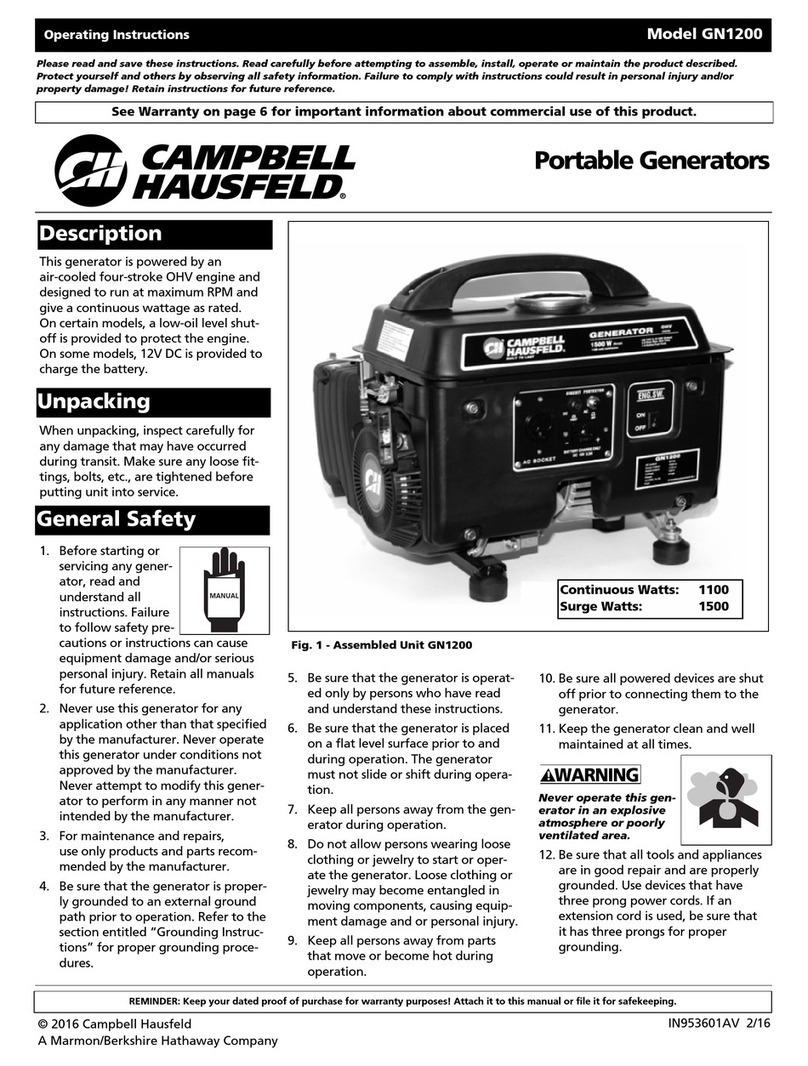
Campbell Hausfeld
Campbell Hausfeld GN1200 operating instructions
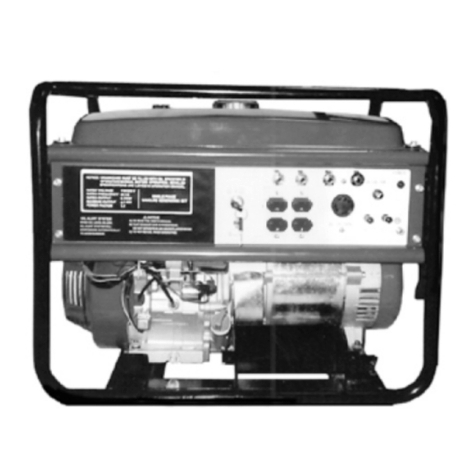
Chicago Electric
Chicago Electric 98838 Operation instructions
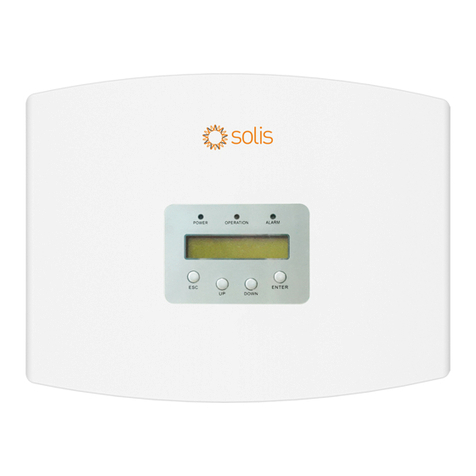
SOLIS
SOLIS Solis-EPM1-5G Installation and operation manual
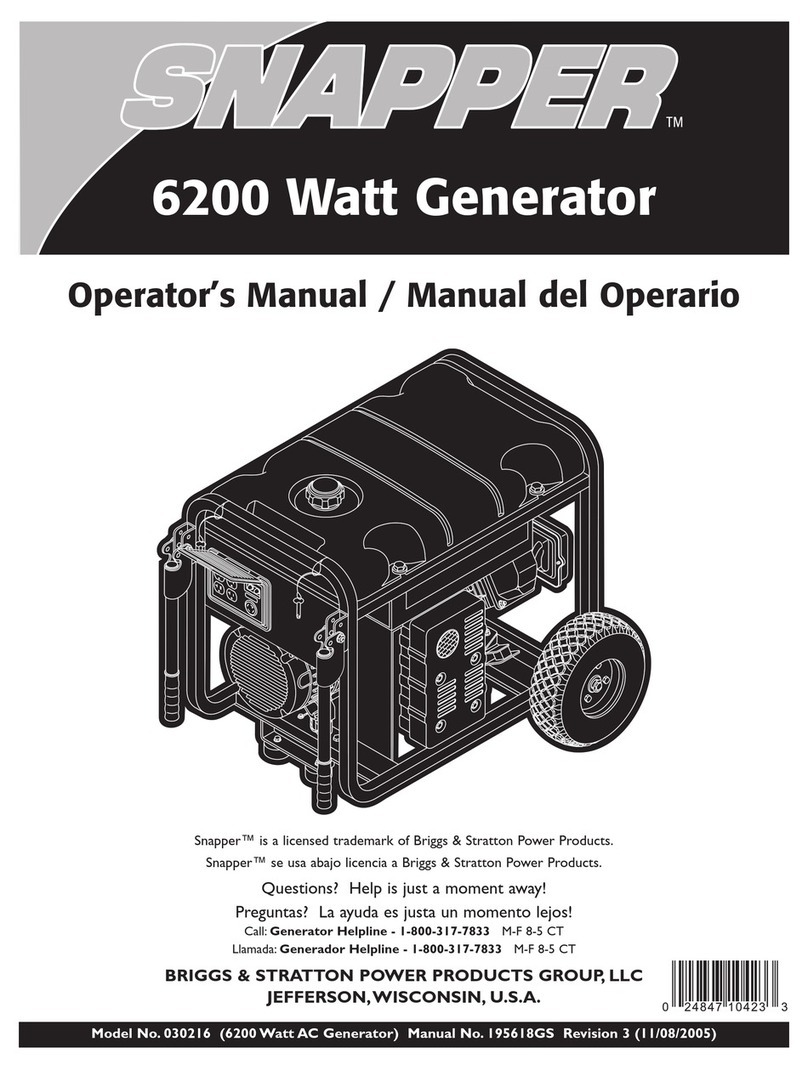
Snapper
Snapper 30216 Operator's manual
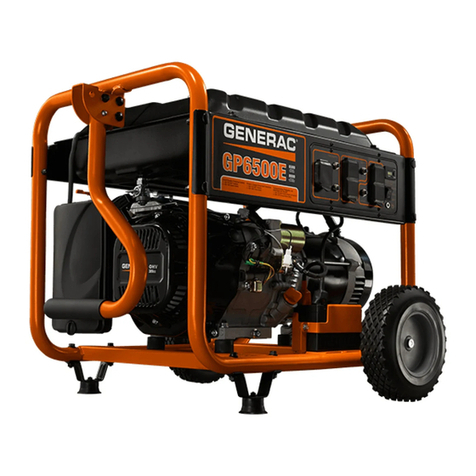
Generac Portable Products
Generac Portable Products GP Series owner's manual
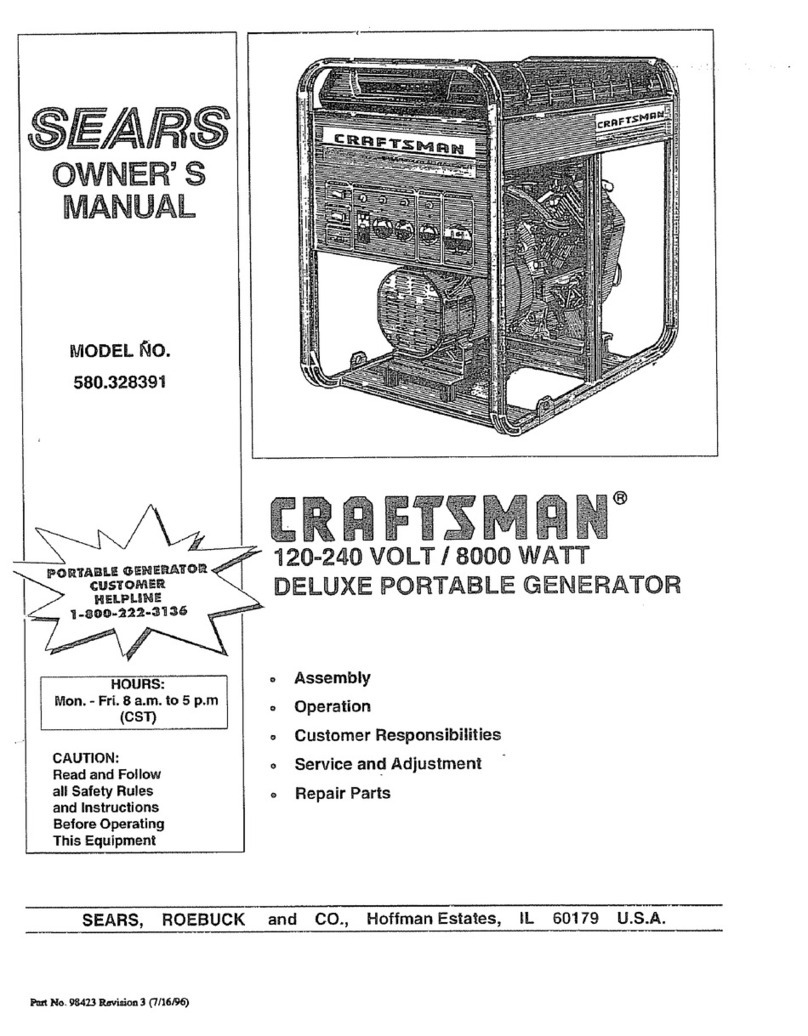
Craftsman
Craftsman 580.328391 owner's manual
